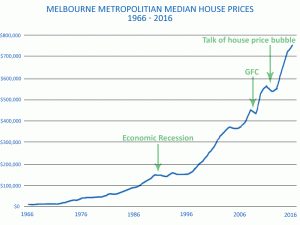After a sustained period of solid growth in the Melbourne residential property market, we’re seeing a significant switch from what was a seller’s market to a buyer’s market.
Auction clearance rates are down to circa 60% from a high of 82%, the number of bidders at auction has reduced to an average of 2 (from a high of 5) and many auctions are now being passed in on “vendor bids”, which often means that a bid from the crowd was not received on the day.
The change in the market has been brought about by three principal factors:
1. The major banks have tightened their lending practices… lower loan to value ratios (LVR’s) and stricter lending criteria.
2. Overseas buyers now operate under tighter regulation which makes it more difficult and more expensive for them to hold property in Australia. This has significantly reduced market competition.
3. Adverse media commentary surrounding household debt in Australia and the prospect of interest rate rises in the foreseeable future.
What the changes in the market mean
It is in these changing times that people tend to “close up shop” by postponing the purchase of their new home and/or investment property. While this is a perfectly understandable response, it could also prove to be a time of lost opportunity.
We are now seeing examples of real value in the real estate market. There are still motivated sellers and in some cases, fewer buyers. Not all properties are being advertised to the open market, many are being offered “off-market” and at very realistic prices that reflect the changed real estate conditions.
The key is to make sure you buy at today’s value which is not always its price. In the words of the great Warren Buffett: “Price is what you pay, value is what you get”. The message is to get value in the price you pay.
The Melbourne market
The following graph shows the trend in Melbourne’s median house prices from 1966 to 2016. It demonstrates the resilience of real estate historically to withstand the most severe of financial downturns.

Between 1990 to 1992, interest rates in Australia were hovering around 16-18% in the “recession we had to have” according to our then Federal Treasurer, Paul Keating. A fall in house prices was followed soon after by a long, sustained period of exponential price growth over a period of some 16 years, but for some minor short term dips along the way. In 2008, world financial markets were thrown into turmoil with the Global Financial Crisis. Within 18 months, following a short term drop in overall property prices, the market recovered to register yet another period of solid growth.
It is impossible to predict how long the current dip in property prices will last but history tells us that those who purchase in times of subdued property market conditions can stand to make exceptional gains in the medium to long term.
If you are thinking of buying and/or selling in the foreseeable future and would like some assistance in putting together a strategy, BidPro’s Property Advocates can provide guidance to ensure you’re getting value with the property you purchase.
The content of this article was written by Shane Heffernan, Managing Director of BidPro. The information contained in it is general and is not intended to serve as advice. DPM Financial Services Group recommends you obtain advice concerning specific matters before making a decision.
Authors
Shane Heffernan – Managing Director, Bidpro Property Advocates





